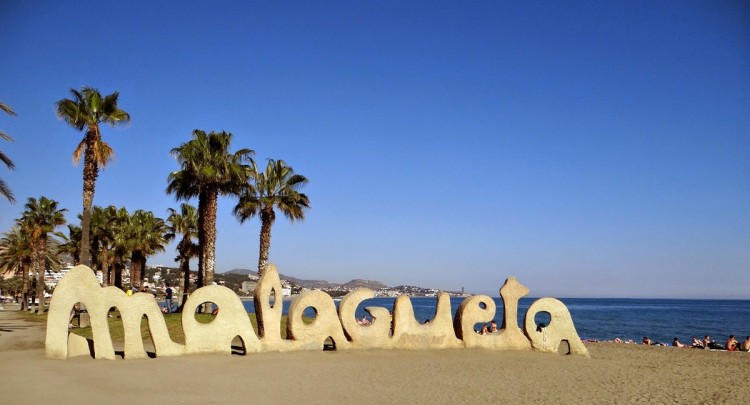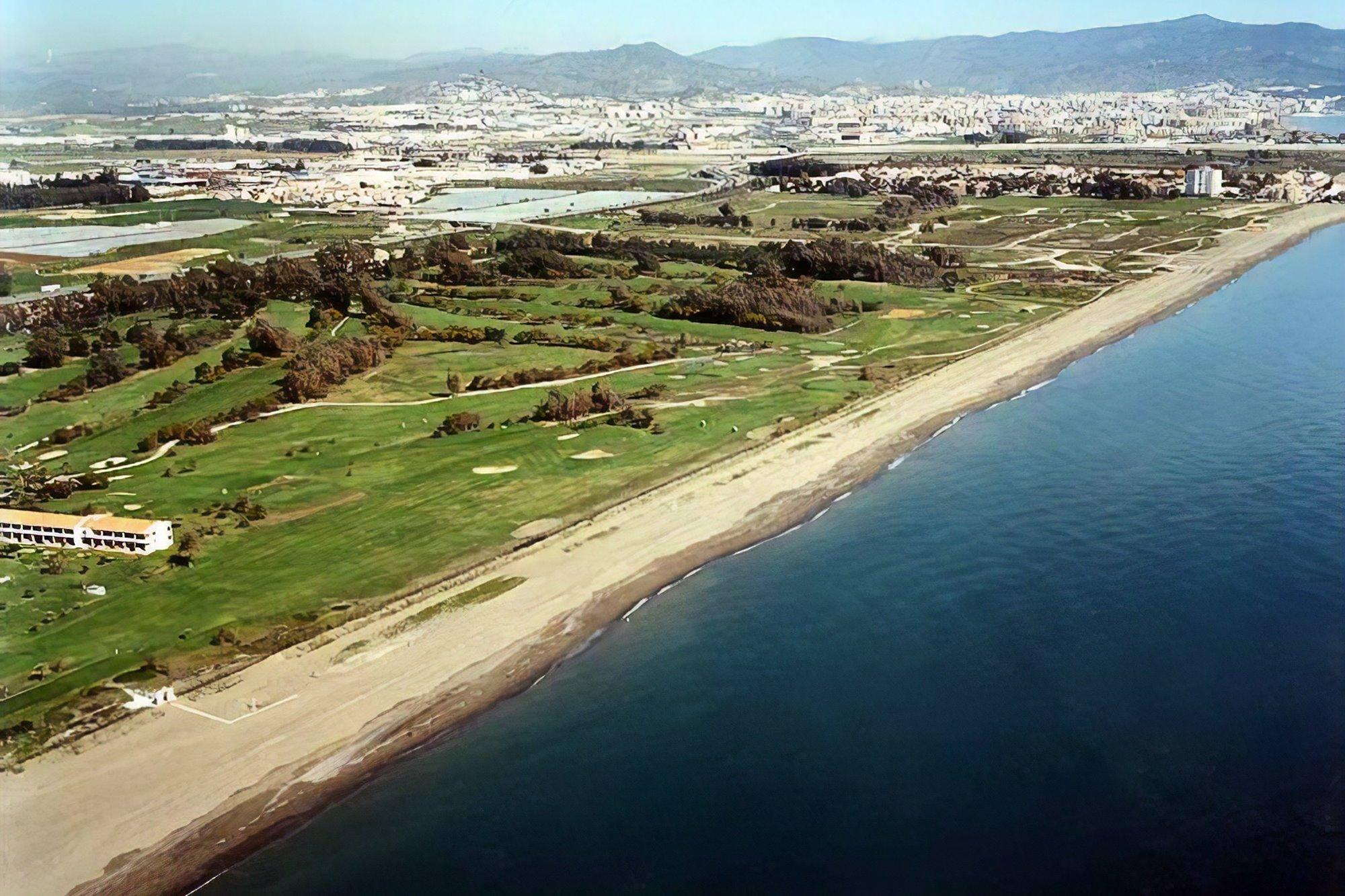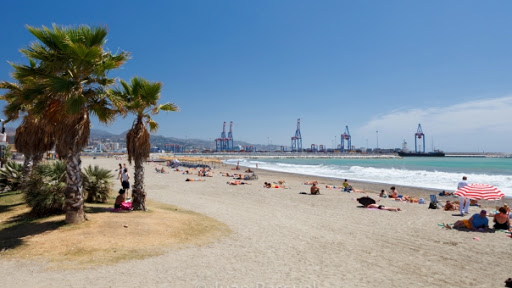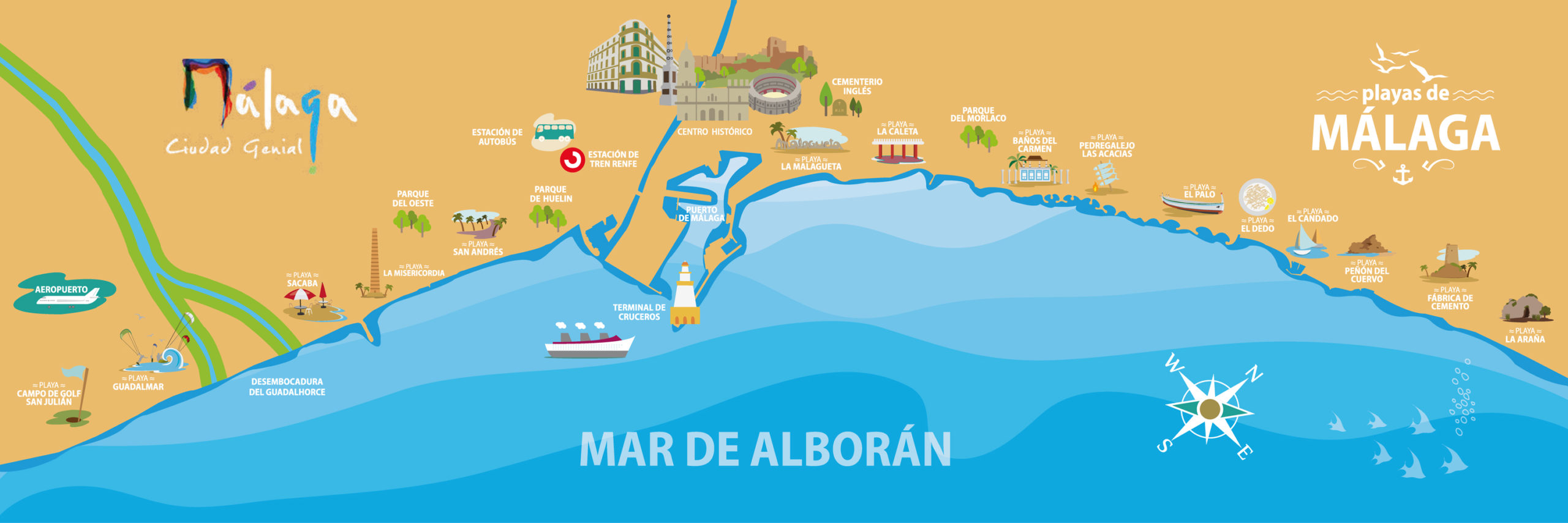The Malagueta

With 1200 m. in length and 45 m. wide, La Malagueta is the closest beach to the port of Malaga towards the East. It is one of the beaches most visited by the people of Malaga due to its connection to the city and its easy access.
La Caleta
Located between the Malagueta and the Baños del Carmen, this beach takes its name from the stately neighborhood to which it belongs, chosen as a residential area by the upper bourgeoisie at the end of the 19th century to build their luxurious villas and palaces. La Caleta beach has a length of 1000 m. and an average width of 25 m. and maintains a high degree of occupancy due to its accessibility and proximity to the historic center.
Baths of Carmen
The Balneario del Carmen was inaugurated in 1918 with a totally new and focused concept, above all, to satisfy the demands of the Malaga bourgeoisie and the increasingly frequent foreign tourists. It came to have a jetty, Tennis courts, football field, restaurant, dance floor of 2000 m² and up to an aquarium. The arrival of the tourist boom in the years 60 and finally the law of free access to the beaches of the years 80, made the format obsolete. A rehabilitation plan is currently in process. With 550 m. in length and 15 m. Wide, The Baños del Carmen beach is a symbol for the people of Malaga, for its historical baggage and for its enclave, from where you can enjoy beautiful views of the bay of Malaga.
San Julián golf course

It is the westernmost beach in the municipality of Malaga and takes its name from the golf course next to which it is located.. It is a semi-urban beach with a low degree of occupation and surrounded by vegetation. Their 2.250 m. in length and 50 m. maximum width make it the largest beach in Malaga with space for a soccer field and barbecue area. It is the only urban beach that has a nudist area, with a length of 300 m, which has the following furniture: showers, litter bins and wooden walkways.
Guadalmar
From the Golf Course to the mouth of the Guadalhorce, Guadalmar beach has been formed over time by the sediments carried by the riverbed. It is the closest to Malaga airport. With 450 m. in length and about 30 m. wide Guadalmar is a protected beach with a medium occupancy rate.
Took out
The strip that runs between the mouth of the Guadalhorce and the beach of La Misericordia, is Sacaba. One of the quietest beaches in the west of the city of Malaga, for being surrounded by an old industrial zone, today in the process of conversion and with low population density. Sacaba has a length of 750 m. Y 60 m. wide and in it there is a single urbanization built in the years 60, Sacaba Beach.
Mercy

This beach owes its name possibly to the location of a provincial asylum and hospice called Casa de la Misericordia, built at the beginning of the 20th century and which was in operation until 1978. Today the building is the Civic Center. La Misericordia beach reaches an approximate length of 2000 m. and ones 30 m. wide. It is one of the most popular beaches in Malaga and on its promenade some of the chimneys, vestige of the industrial Malaga of the 19th century, are still preserved..
Saint Andrew

It is located between La Misericordia beach and the Port in the western area. It seems that it owes its name to an old hermitage that was built by the fishermen who used to fish on these beaches., to honor Saint Andrew as his patron and protector. San Andrés beach has about 650 m. in length and 50 m. wide. It is a very busy beach thanks to its accessibility through the wide promenade that runs throughout the area.
Pedregalejo Las Acacias
The origin of the name of this neighborhood is not very clear. Some attribute it to the scree formed by the San Telmo quarry exploited at the end of the 19th century and, Nevertheless, in cartography dating from the end of the 18th century, the place name "Pedregalejo beach" already appears.. It is one of the oldest and most traditional fishing districts in Malaga. With a length of 1200 m. and an average width of 20 m., this beach has the oldest promenade in the city, famous for the number of restaurants specializing in fish and seafood that it has. Pebble beach formerly today is fully regenerated with breakwaters.
The stick
There are several theories and legends about the origin of the place name "El Palo". The truth is that according to the historian Víctor Heredia, on the way to Velez-Malaga, there was a “ventorrillo de el Palo” that could be its explanation and the origin of the population nucleus that gave rise to this neighborhood. From the Arroyo Gálica to Pedregalejo, the beaches of El Palo have a length of 1200 m. and a width of 25 m. The seafaring vocation of this nucleus is still valid today, with the presence on its beaches of the boats with which the fishermen continue to fish in the area.
Finger
The beach of the finger, also known as the Chanquete beach, It extends from the beaches of El Palo and Arroyo Gálica to the Puerto Deportivo de el Candado. It is a beach with a family atmosphere. With 550 m. in length and about 25 m. Wide, The beach of El Dedo or Chanquete is very visited because it is where El Tintero is located, one of the most famous beach bars on the Malaga coast for its peculiar way of serving fish in a kind of "auction".
The lock
Located between the El Candado marina and the Peñón del Cuervo beach, this small coastal strip takes its name from the residential area, built over the years 60, to which the Nautical Club and its marina belongs, one of the oldest on the Malaga coast. The Candado beach has 200 m. long and 30 m. medium width, and maintains a high level of occupancy by the users of the marina.
Raven Rock
Between the marina of El Candado and the Cement Factory, Peñón del Cuervo beach takes its name from a rock formation that, like an isthmus, divides the beach into two areas. Concerts are usually organized on this beach, Moragas and also has an area enabled for barbecues. With 450 m. long and 25 m. medium width, El Peñón del Cuervo is an important protected biological enclave, because in it is the always alive malagueña (limonium malacitanium), an endangered plant.
The spider
The neighborhood of La Araña is the easternmost nucleus of the municipality of Malaga. It is a typical fishermen's neighborhood located in the same coastal area, where today it continues to fish so it is common to find boats and fishing equipment on its beach. With a length of 500 m. and an average width of 25 m. Before arriving at Cala del Moral, and in the strip that adjoins the Araña beach and the Arroyo Totalán, a dog beach has recently been enabled, where users can enjoy with their pets. This being the last beach in the eastern area of Malaga.
Cement Factory
Between the Peñón del Cuervo and the neighborhood of La Araña is the beach of La Fábrica de Cemento, so called because it is right in front of the facilities of the Malaga cement factory that has been in operation since 1915. This beach has 350 m. in length and about 15 m. maximum width. Due to its seafaring tradition, The neighborhood of La Araña is well known for the quality of the fish offered by its beach bars and restaurants.
